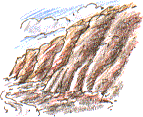Mappleton, East Yorkshire
 
Beachcombing
Sunday 9th
April 2000




 Nature Diary
Rocks
History
Workshop
Links
Home Page
Nature Diary
Rocks
History
Workshop
Links
Home Page

 HOLDERNESS, East Yorkshire, is said to have the fastest rate of coastal erosion in the world. Boulder Clay cliffs offer limited resistance to the full force of the sea and, perhaps more crucially, they are prone to landslips.
HOLDERNESS, East Yorkshire, is said to have the fastest rate of coastal erosion in the world. Boulder Clay cliffs offer limited resistance to the full force of the sea and, perhaps more crucially, they are prone to landslips.
When I last visited Mappleton in 1991, the sea defences had just been put in place. Boulders the size of large freezers had been shipped in from Scandinavia. They had been arranged in a protective fan at the end of an access track down to the beach and as a narrow breakwater of boulders stretching out to sea. During the last nine years, the breakwater has acted as a barrier to the movement sand and pebbles along the shore. This beach-making material would normally gradually move southwards,as a result of longshore drift.
 There is now sufficient beach to protect the village of Mappleton but, on the other side of the breakwater, it's a different story. The beach level is 3 or 4 feet lower. Walk down the shore to the south of the breakwater and the beach begins to peter out altogether. This morning, four or five hours after high tide, there still isn't enough beach showing for us to be able to continue our walk as far as Cowden, just a mile along the coast. Starved of a supply of beach-making materials, this section of coast will now, ironically, be eroded at a faster rate as a result of the new coastal defences.
There is now sufficient beach to protect the village of Mappleton but, on the other side of the breakwater, it's a different story. The beach level is 3 or 4 feet lower. Walk down the shore to the south of the breakwater and the beach begins to peter out altogether. This morning, four or five hours after high tide, there still isn't enough beach showing for us to be able to continue our walk as far as Cowden, just a mile along the coast. Starved of a supply of beach-making materials, this section of coast will now, ironically, be eroded at a faster rate as a result of the new coastal defences.
We found a fossil oyster known as Gryphaea, or 'Devil's Toe-nail', eroded out of the soft cliff.
 A Kestrel hovered at the clifftop, where we saw our first Wheatear, a summer visitor. At nearby Hornsea Mere we saw our first Sand Martins.
A Kestrel hovered at the clifftop, where we saw our first Wheatear, a summer visitor. At nearby Hornsea Mere we saw our first Sand Martins.

Richard Bell,
wildlife illustrator
E-mail; 'richard@daelnet.co.uk'
 Next day
Previous day
Nature Diary
Wild West Yorkshire home page
Next day
Previous day
Nature Diary
Wild West Yorkshire home page

|

 HOLDERNESS, East Yorkshire, is said to have the fastest rate of coastal erosion in the world. Boulder Clay cliffs offer limited resistance to the full force of the sea and, perhaps more crucially, they are prone to landslips.
HOLDERNESS, East Yorkshire, is said to have the fastest rate of coastal erosion in the world. Boulder Clay cliffs offer limited resistance to the full force of the sea and, perhaps more crucially, they are prone to landslips. There is now sufficient beach to protect the village of Mappleton but, on the other side of the breakwater, it's a different story. The beach level is 3 or 4 feet lower. Walk down the shore to the south of the breakwater and the beach begins to peter out altogether. This morning, four or five hours after high tide, there still isn't enough beach showing for us to be able to continue our walk as far as Cowden, just a mile along the coast. Starved of a supply of beach-making materials, this section of coast will now, ironically, be eroded at a faster rate as a result of the new coastal defences.
There is now sufficient beach to protect the village of Mappleton but, on the other side of the breakwater, it's a different story. The beach level is 3 or 4 feet lower. Walk down the shore to the south of the breakwater and the beach begins to peter out altogether. This morning, four or five hours after high tide, there still isn't enough beach showing for us to be able to continue our walk as far as Cowden, just a mile along the coast. Starved of a supply of beach-making materials, this section of coast will now, ironically, be eroded at a faster rate as a result of the new coastal defences.